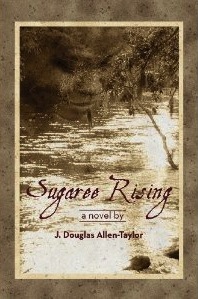 The late Depression-era exodus and relocation of hundreds of families by the Santee Cooper Project—a long-forgotten piece of South Carolina history—has finally been resurrected in literature.
The late Depression-era exodus and relocation of hundreds of families by the Santee Cooper Project—a long-forgotten piece of South Carolina history—has finally been resurrected in literature.
Former longtime South Carolina resident J. Douglas Allen-Taylor and Freedom Voices Publishers of San Francisco have announced plans for a fall, 2012 publication of Allen-Taylor's new novel, Sugaree Rising, a fictional account loosely based on events surrounding the Santee Cooper relocation.
Most South Carolinians and visitors think of Santee Cooper as the popular wildlife and recreation area surrounding two human-made lakes, Moultrie and Marion, that stretch through the heart of the state from the Lowcountry into the Midlands. What is not well-known is that when the massive rural electrification and defense transportation project was begun in 1939—including the building of the Pinopolis dam near Moncks Corner—some 900 families were uprooted in the process, forced to disband their communities and relocate families, homes, farms, churches, and even graveyards to surrounding areas. Many, apparently, did not go quietly or willingly, according to newspaper accounts from the time.
The more famous dam construction and the rural electrification project of the Tennessee Valley Authority (TVA) that preceded the Santee Cooper Project inspired several novels, including two—Bordon Deal's Dunbar’s Cove and William Bradford Huie's Mud On The Stars—that were combined into the 1960 Elia Kazan movie Wild River. However, although there are a handful of non-fiction books about Santee Copper, Allen-Taylor says that to his knowledge, Sugaree Rising is the first novel based upon the South Carolina project.
“It’s a rich history that deserves its own story,” Allen-Taylor says. “I hope my book will inspire more work on that era in South Carolina.”
Sugaree Rising is not a fictional account of the Santee Cooper relocation of 1930-41, but is “inspired by those events,” according to the author. He says he decided not to write a strict recreation of the actual Santee Cooper project because he wanted to include a Gullah-like community in the story. The Gullah communities—descendants of Sierra Leone people who were brought to South Carolina in slavery in the 1700’s and 1800’s and retained many of their African cultural practices—are largely based in the sea islands area, and were not affected by the actual Santee Cooper Project relocation.
The Gullah, Allen-Taylor says, are slowly being eliminated as a distinct people because of the end of the rural culture and geographical isolation that forged their unique identity, and says he saw that as perfectly blending in with the Santee Cooper relocation that destroyed many communities in the lake basins. He stresses that the Yay'saw people of Sugaree Rising should not be considered Gullah, but a population whose history, condition, and culture is similar to the Gullah.
While the lower portion of the actual Santee Cooper Project was based in Berkeley County, Allen-Taylor has set his account in a fictional Cantrell County—which he describes as “somewhere in the vicinity of Georgetown and Williamsburg counties”—and the fictional Sugaree River, which he modeled after the Santee River.
Allen-Taylor says he was first drawn to the Santee Cooper relocation some forty years ago, when he lived in Berkeley County.
“I once asked an older gentleman where his original home was located, and he pointed out over the lake,” Allen-Taylor says. “I thought he was talking about one of the communities on the far shore, but he actually meant in the middle of the lake itself. He told me stories about how whole communities had to take up and leave, and how they could never visit their old homes again, because those homes were under water. It was heart-rending.”
The author says he was further moved by the story when he saw what he called “absolutely poignant” photographs of residents uprooted by the relocation project collected by the federal Farm Security Administration/Office Of War Information (FSA/OWI). “I kept the story in the back of my mind for years,” he says. “I never forgot it. I wanted to tell these people’s stories.”

